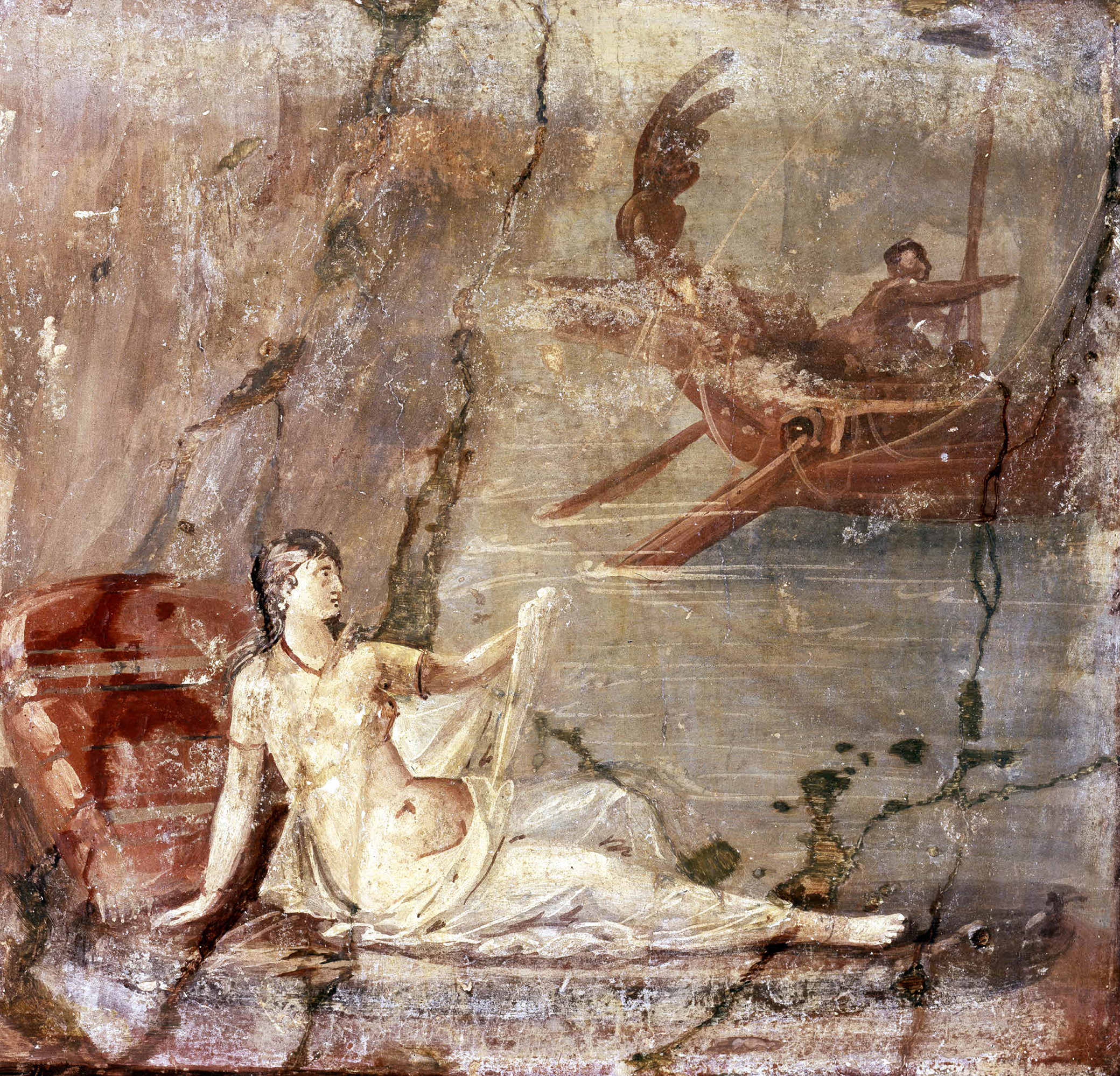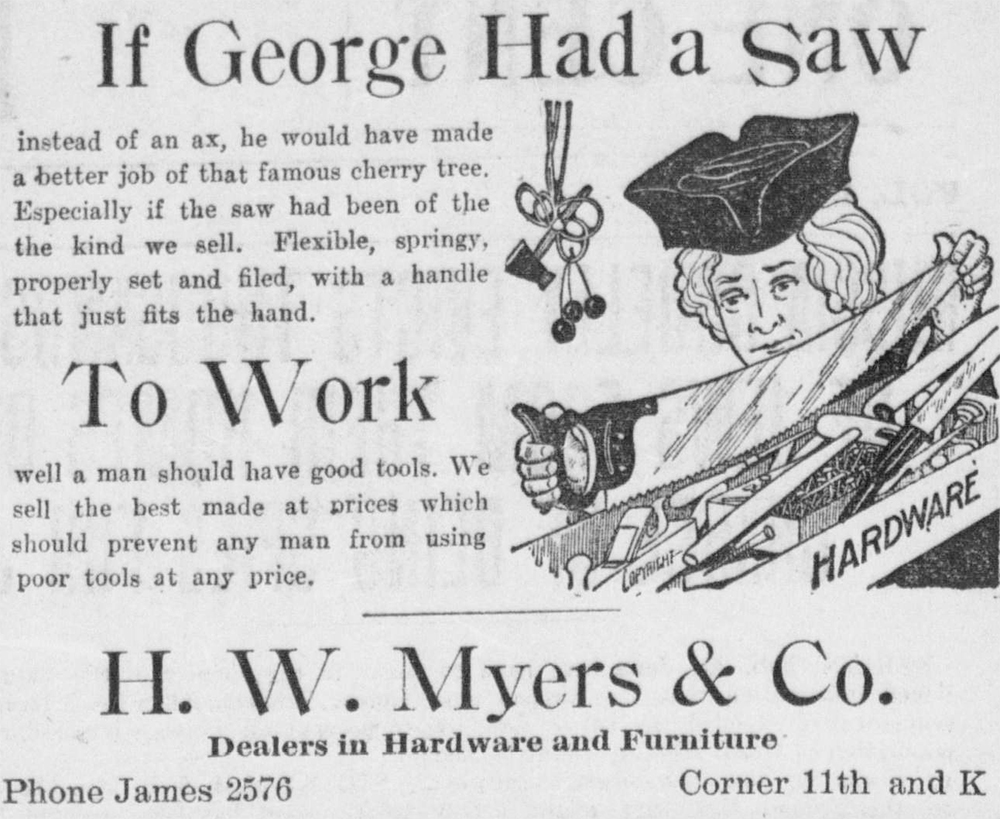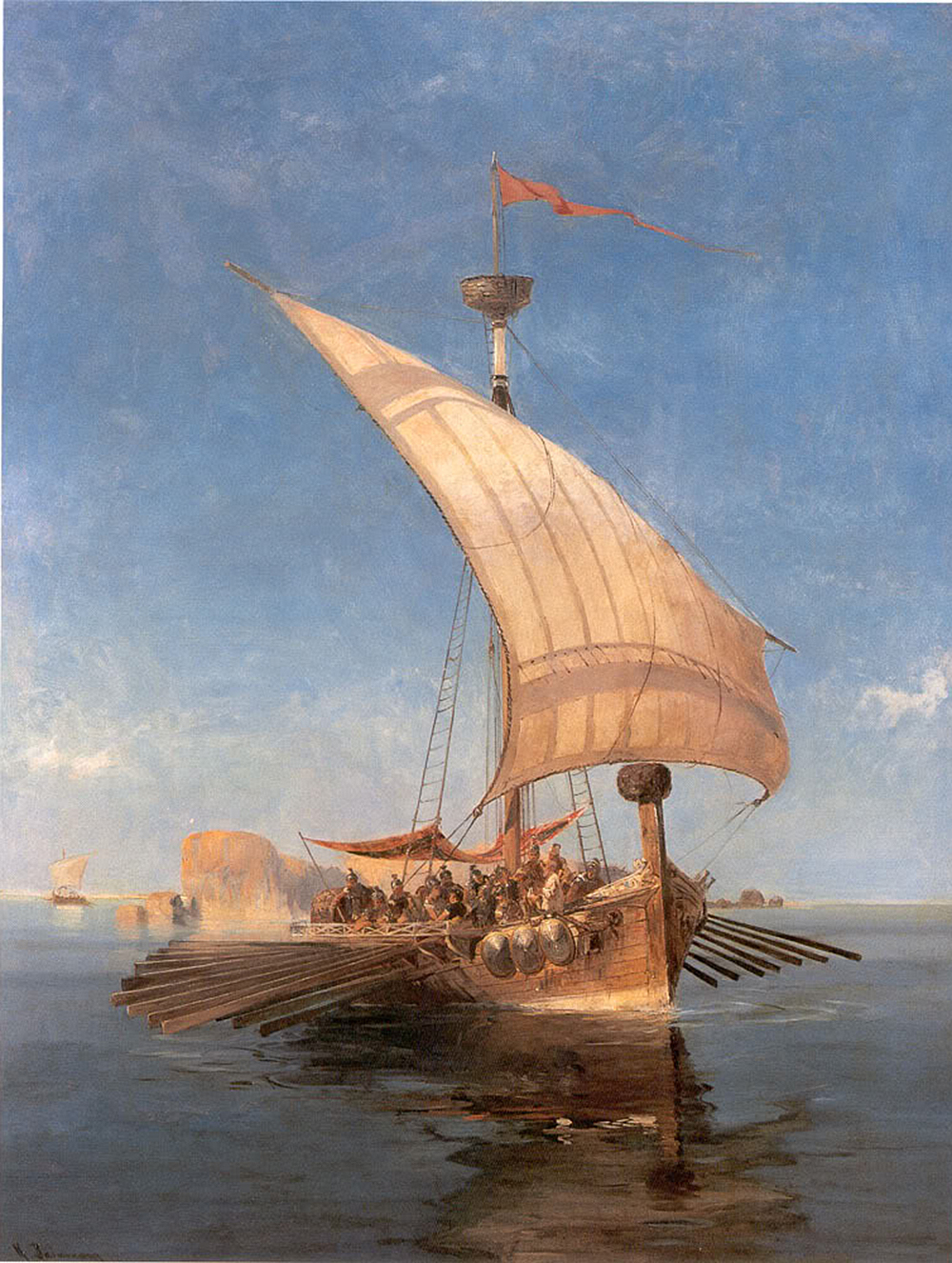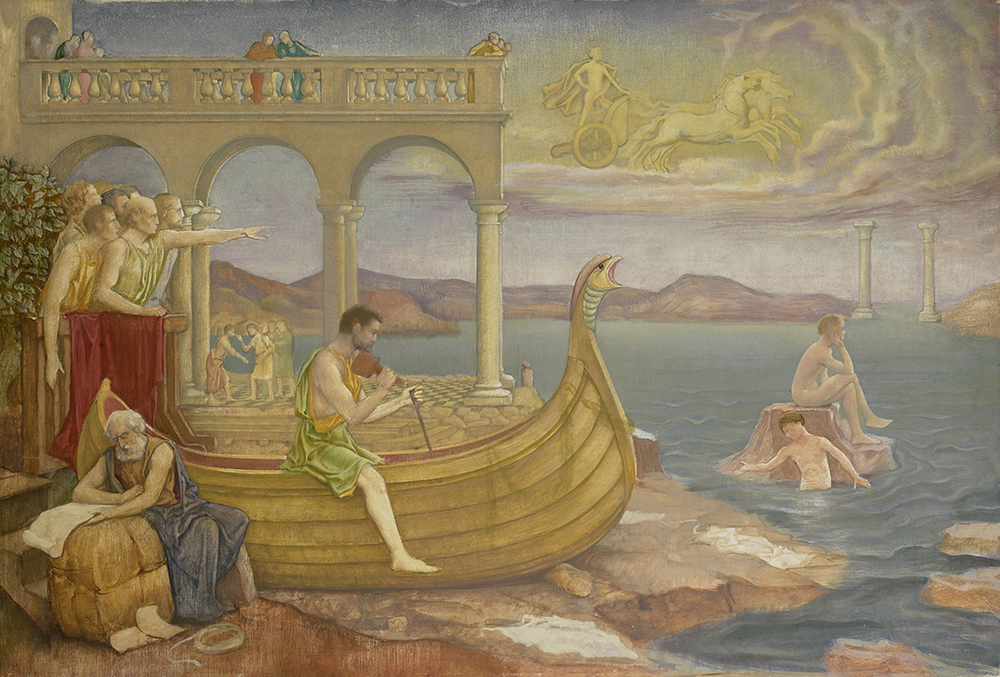
Ariadne pointing at the ship of Theseus sailing away in the distance, wall painting, first century bc. © The Trustees of the British Museum.
Audio brought to you by Curio, a Lapham’s Quarterly partner
The thought problem known as the ship of Theseus first appears in Plutarch’s Lives, a series of biographies written in the first century. In one vignette, Theseus, founder-hero of Athens, returns victorious from Crete on a ship that the Athenians went on to preserve.
They took away the old planks as they decayed, putting in new and stronger timber in their place, insomuch that this ship became a standing example among the philosophers for the logical question of things that grow; one side holding that the ship remained the same, and the other contending that it was not the same.
Whether the ship was a familiar philosophical example at the time is any historiographer’s guess. Plutarch is known for taking liberties as a biographer, and most of his source texts have been lost to time. The ship of Theseus may have been ancient in Plutarch’s day. It also may have just been a colorful anecdote. The veracity of Plutarch’s story seems especially dubious when we consider that Theseus himself likely never existed. Theseus had two fathers, Aegeus and the Greek god Poseidon; his victory in Crete was slaying the Minotaur. As a mythological figure, he is only slightly more paradoxical than that of the thought problem bearing his name.
Of course, the conundrum of how things change and stay the same has been with us a lot longer than Plutarch. Plato, and even pre-Socratics like Heraclitus, dealt in similar questions. “You can’t step in the same river twice,” a sentiment found on inspirational Instagram accounts, is often attributed to Heraclitus. His actual words—“Upon those who step into the same rivers, different and again different waters flow”—might not be the best Instagram fodder but, figuratively at least, provided the waters that the ship of Theseus later sailed.

Two thousand years later the ship is still bobbing along, though some of its parts have been replaced. Now known colloquially as Theseus’ paradox, in the U.S. the idea sometimes appears as “Washington’s ax.” While not as ancient as the six-thousand-year-old stone ax discovered last year at George Washington’s estate, the age-old question remains: If Washington’s ax were to have its handle and blade replaced, would it still be the same ax? The same has been asked of a motley assortment of items around the world. In Hungary, for example, there is a similar fable involving the statesman Kossuth Lajos’ knife, while in France it’s called Jeannot’s knife.
This knife, that knife, Washington’s ax—there’s even a “Lincoln’s ax.” We don’t know where these stories originated. They likely arose spontaneously and had nothing to do with the ancient Greeks and their philosophical conundrums. The only thing uniting these bits of folklore is that the same question was asked: Does a thing remain the same after all its parts are replaced? In the millennia since the ship of Theseus set sail, some notions that bear its name have less in common with the original than do the fables of random axes and knives, while other frames for this same question threaten to replace the original entirely.

One such version of this idea is attributed to Enlightenment philosopher John Locke, proffering his sock as an example. An exhibit called Locke’s Socks at Pace University’s now-defunct Museum of Philosophy serves to demonstrate. On one wall, six socks were hung: the first a cotton sports sock, the last made only of patches. A museum guide, according to a New York Times write-up, asked a room full of schoolchildren, “Assume the six socks represent a person’s sock over time. Can we say that a sock which is finally all patches, with none of the original material, is the same sock?”
The question could be asked of Theseus’ paradox itself. Can it be said that a paradox about a ship remains the same if the ship is replaced with a knife or a sock? Have we lost anything from Theseus’ paradox if instead we start calling it “the Locke’s Sock paradox”?
Many have already started to. An episode of The Good Place has “Locke—Parable of the Sock” scrawled across a classroom chalkboard. The notion is explicated at length in the video game 999. It appears in teaching texts like Philosophy for Dummies. References to it even outnumber news reports of a sock puppetry scandal involving a contemporary author named John Locke.
Locke’s version does have a nice ring to it. And the metaphor holds up under examination. It might even be preferable—socks are less serious than ships, making them better teaching tools. And that’s how easy it is for some worn-out socks to replace a two-thousand-year-old paradox. Except for one small problem. Scholars are unable to locate any references to socks in Locke’s work. The English philosopher discussed many questions of identity but apparently left his garments out of it. This may or may not be enough reason to retire the socks once and for all. It also may or may not explain why pairs of John Locke socks for sale on Etsy have neither holes nor patches.
Holes notwithstanding, Locke’s Socks probably aren’t going away anytime soon. As the current identity paradox par excellence, its popularity could eclipse Theseus’ ship. A curator at a future museum of philosophy might one day have to decide if the ship of Theseus is part of the history of Locke’s Socks or if it’s the other way around. It may seem like just a name change, but, really, what is a paradox if not the words that it consists of? What is a name if not the vessel that holds an idea together?
The role of the name in this particular paradox is something inadvertently addressed by Roland Barthes. In his 1977 autobiography Roland Barthes by Roland Barthes, he briefly mentions a ship named Argo, “each piece of which the Argonauts gradually replaced so that they ended up with an entirely new ship, without having to alter either its name or its form.” Barthes goes on to explain that the Argo “affords the allegory of an eminently structural object” created by “two modest actions”: nomination and substitution. Clearly he is speaking of the ship of Theseus (an object Plutarch made paradoxical by assigning it a name, which persists in time, and a composition, which does not). We should be relieved that at least our ship is again a ship. Interestingly, though, the name of Theseus’ ship was not Argo. Plutarch did mention a ship called Argo, which Theseus was said to have sailed. It was not, however, the ship Theseus sailed from Crete. It is unclear whether Barthes knew this, and it begs the question: Is a paradox about a ship of Theseus the same as the paradox about the ship of Theseus? To the reader, perhaps. But to Barthes, perhaps not—he probably had his reasons. (Though, being Barthes, he likely would have insisted his authorial intentions were not relevant.)

Later in the book, Barthes invokes the Argo in a discussion about how lovers communicate, writing of the words “I love you” that “the very task of love and of language is to give to one and the same phrase inflections which will be forever new.”
Like the Argonaut renewing his ship during its voyage without changing its name, the subject in love will perform a long task through the course of one and the same exclamation… thereby creating an unheard-of speech in which the sign’s form is repeated but never is signified.
This brief mention might have been forgotten were it not for the success of a 2015 book, The Argonauts by Maggie Nelson. The title is a direct reference to Barthes’ Argo and, in Nelson’s words, also refers to a “foundational metaphor” in her book. Her Argo retains what Barthes imparted to it vis-à-vis the discourse of lovers. Nelson also floats it as a metaphor for the paradox of selfhood, of the “I” which is immutable yet undergoes constant change: “We develop, even in utero, in response to a flow of projections and reflections ricocheting off us. Eventually, we call that snowball a self (Argo).” There may be nothing new about the paradox of selfhood, but insofar as identity has increasingly become a question of social and political import, Nelson’s Argo provides a useful contemporary name for it.
There may be little difference to us whether Theseus’ ship is replaced by the Argo. But if the Argo has become a vessel for the conundrum of selfhood, the wind in its sails a lovers’ whisper, is that ship not changed? Has the original paradox now been enriched, or entirely supplanted?
In 1994 artist and activist Ai Weiwei began working on a series he would continue for years, in which he painted the Coca-Cola logo on an assortment of Chinese vases as ancient as Theseus’ paradox itself. His work with two-thousand-year-old vessels was not limited to painting: in 1995 he became the talk of the art world with Dropping a Han Dynasty Urn. The piece comprises three photos depicting Weiwei holding, then letting go of, a large ceremonial urn; the last photo shows shards of ceramic lying at his feet. The piece was immediately controversial. Though Weiwei was the owner of the urn, did that give him the right to break it? And if so, did breaking it classify as art, or was it merely a political gesture?
Weiwei’s status as an artist has grown significantly since then, largely putting to bed the question of whether Dropping a Han Dynasty Urn is art. But the question continued to pop up. In 2012 Swiss art collector Uli Sigg, owner of one of the Coca-Cola urns, made a newsworthy work of his own when he dropped the urn in the same manner Weiwei had. The piece, captured in a photographic triptych called Fragments of History, shows Sigg using Weiwei’s same openhanded gesture, with the last image displaying the shattered shards at his feet. Two years later, at an Ai Weiwei art exhibit in Miami, Dominican artist Maximo Caminero continued the tradition by grabbing one of Weiwei’s Colored Vases urns off a display plinth and dropping it openhandedly. After initially describing his act as a protest, the “vandal” changed tack, apologized, and pled guilty to felony criminal mischief. He was sentenced to eighteen months’ probation and a hundred hours of community service. Caminero was also forced to pay $10,000 for the urn.
Weiwei’s choice to break an ancient vase (two, in fact—the first one fell before the photographer could capture it) could be seen as a representation of Picasso’s famous quip that every act of creation is firstly an act of destruction. The other acts of destruction—that of the art collector and the Miami artist—are perhaps less convincing. Those urn-breaking incidents are in conversation with the original, which makes them easy to dismiss as derivative. Still, each subsequent act built upon what came before it, inscribing new interpretations on what it means to destroy an ancient artwork just as Weiwei had inscribed “Coca-Cola” in red ink.

In the destruction, one could argue that new artworks were formed—Sigg’s Fragments of History or even the broken pottery itself. Japanese kintsugi is an ancient method of pottery repair. As an art form, it is the mending of broken ceramics with gold lacquer. As a philosophy, it sees breaks, cracks, and repairs as part of an object’s history. In the eyes of a kintsugi artist, none of the smashed urns were destroyed: the fragments remained; they just needed to be put back together. Gaps even can be mended with pieces of other objects, known in kintsugi as the joint-call technique.
One wonders how art collectors would react if Weiwei’s Han dynasty urn were restored by a kintsugi artist. How would the involvement of a third party have an impact on the sameness, and therefore value, of the original object?
It is the impact of such a third party that English philosopher Thomas Hobbes considered in De Corpore. Picking up where Plutarch left off, Hobbes extended Theseus’ paradox to include another what if: What if the discarded parts of the original ship were collected by “some man” (his words) and used to create a second ship?
Most of the philosophical arguments and proposed solutions that address Theseus’ paradox speak to Hobbes’ version. One of the more thorough arguments is by philosophy professor S. Marc Cohen. It posits two versions of the ship of Theseus: one simple, in which the ship’s parts are replaced, and one complex, in which a “scavenger” collects the discarded parts and builds from them a second ship. Hobbes is not mentioned, but his “some man” is recognizable as the scavenger. Similarly, the educational platform Khan Academy, in a video series on metaphysics, explains the ship of Theseus by juxtaposing “Ship A,” which underwent change, with “Ship B,” made of Ship A’s material. This time, the second ship was credited to Hobbes, a third party who “added a twist to the story.” But is it a twist to the story or another story entirely? If modern-day versions ask us to compare two ships, one from the original paradox of Plutarch’s and the other from Hobbes, does that not underscore their difference? As a thought experiment, Hobbes’ version solicits different philosophical proofs and can float on its own like the second ship it posits. Yet it is considered to be a mere addition, a twist—just another plank on Theseus’ ship.
In the video game Katamari Damacy, a magical adhesive ball rolls around and things get stuck to it: coins, bananas, tricycles, screaming people. The ball grows in size and eventually can pick up lampposts, hot-air balloons, stadiums, whole islands. Even when the ball comprises disparate objects, it never stops rolling—it never stops being a ball. The ship of Theseus is like that ball: it started as a paradox about change, and over time things got stuck to it. It may consist of different things now, but each successive alteration only has augmented its paradoxical nature. For, if Theseus’ paradox holds when the ship is the Argo, and when the ship is a sock, and a knife, and an ax, and even a second ship, then so, too, might it hold Weiwei’s urn—a hypothetical urn that is repaired, kintsugi-style, and smashed again, and repaired and smashed ad infinitum? Can we smash the urn to bits forever without breaking Theseus’ ship? Perhaps the answer must be yes—asking it brings us back where we started, wondering just how much change something can withstand without it changing into something else.
“A paradox,” Maggie Nelson has written, “is more than the coexistence of opposing propositions or impulses. It signals the possibility—and sometimes the arrival—of a third term into a situation that otherwise appeared to consist of but two opposing forces.” Time and again, the question arises: Is it the same, or is it different? And now: Is it still the same, or is it different? Like a vessel that has survived antiquity to the present, the paradox is made not from a simple either/or but through constant additions of and.